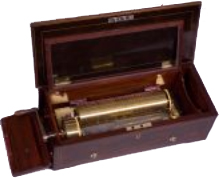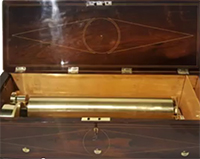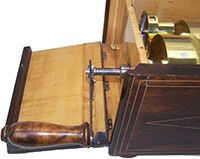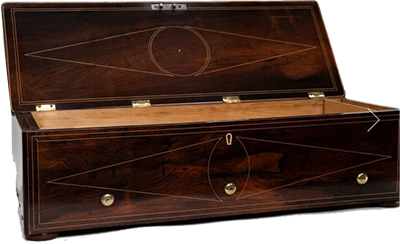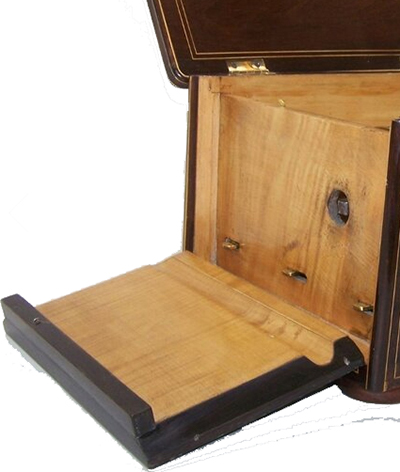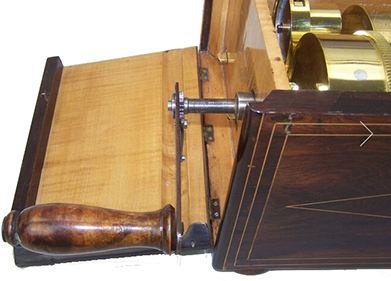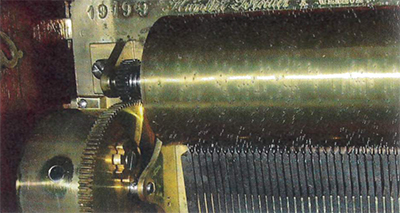|
Humbert Humbert Brolliet Geneva. Partnerships which are recorded in horological circles include Humbert & Perrelet, Humbert et Darier and Humbert-Droz, the latter, presumably the union of two family names by marriage, referred to by Chapuis & Jaquet (The History of the Self-Winding Watch) as a `Swiss watchmaker … who had emigrated to Philadelphia after living in England several years´. A watch has been seen marked Humbert à Langres. As a maker of musical boxes, Humbert Brolliet made items of outstanding dexterity. One is recorded as playing twenty-four tunes, three per turn, each revolution taking three minutes. All Humbert boxes of all name combinations so far seen have circular or bun-type feet and a diamond-shaped stringing inlay on the case front and inside lid while lid tops have brass inlays.
Nr. 17658
The tunes are well arranged, there are some minor squeaks since the majority of the feather dampers perished. reconditioning. The plane brass bedplate is numbered and signed “Humbert Brolliez à Geneva” Nr. 18312
Cylinder 51cm x 11.5cm https://www.facebook.com/musicalbox.be/videos/gigantic-cylinder-music-boxsigned-humbert-brollietmade-about-1850cylinder-51cm-x/1377155202431488/ Nr. 18842 Cylinder of 51 cm length and a diameter of about 11.5cm (!)
The mechanism has a large spring motor and plays 24 tunes in a 3 per turn setting (one turn of the cylinder takes about 3 minutes). The plane brass bedplate is numbered and signed “Humbert Brolliet à Geneva”. On the left there is a tune indicator. The mechanism is attached with 3 screws to the front and 3 screws to the back of the case. The case is of absolute top quality, with rosewood to all sites and stringing to front, left and right, and the inside of the lid. The top of the lid is just outstanding in the fine inlay, with engraved brass and mother of pearl. Even the sides of the lid has inlay with 2 brass strings… This music box is box is pictured in “the music box a guide for collectors” by Ord-Hume on page 123 and on page 288 in the same book one reads : “… As a maker of music boxes, the name Humbert Brolliet, first name unknown, is associated with item demonstrating outstanding dextirity…”, and “ …All Humbert boxes of all name combinations so far seen have circular or bun-type feet and a diamond-shaped stringing inlay on the case front and inside lid while the lid tops have brass inlay.”
Nr. 19799
„Made about 1850 [...] the style of movement and serial nummer suggest it was made by F. Lecoultre Frère, cylinder 10.5 inch long, comb 102 teeth“ (Bellamy 2015, Plate 3.12, page 67) Humbert Frères Joseph Humbert was working in Paris in 1789 and went to Geneva and then to Le Locle in 1795. By 1800, he was making mechanical singing birds. Aimé Humbert (brother? son?) lived in Neuchatel and became president of the Watchmakers´ Union in 1860. Musical boxes have been seen stamped Humbert Frères.
|

